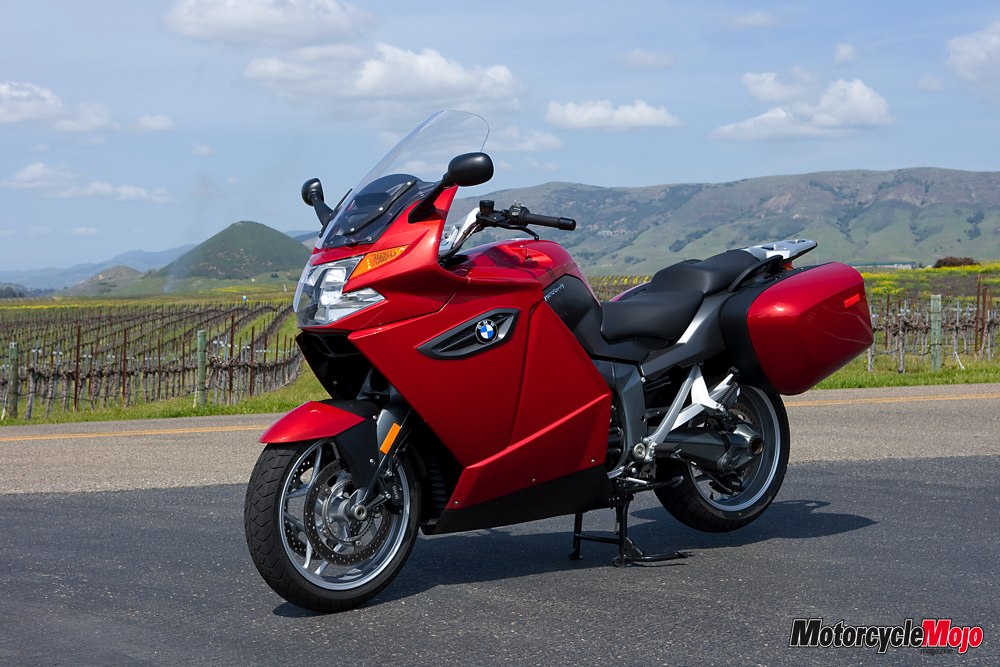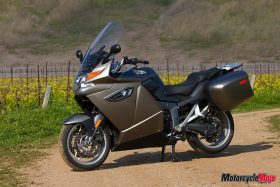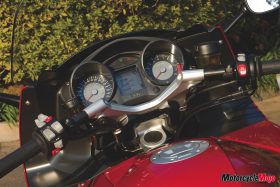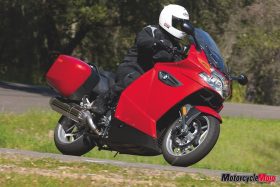Hopefully, he doesn’t have his radar gun pointed in our direction is my first thought when I see the Police car at the junction. We have just pulled onto the highway and running up hard through the gears, there’s no doubt we are over the speed limit. Rolling off to make the turn in front of the squad car, we glide silently by in close formation. A mild mannered looking group of riders, sensibly dressed on whisper quiet touring rigs. The policeman doesn’t bat an eye. Rewind the tape ten minutes and nothing could have been further from the truth. Diving into hairpin turns, blitzing up to triple digit speeds on the short straights, this group of journalists was on a mission to see where the limits of the new BMW K1300GT lay. All highly experienced riders, we were taking advantage of the deserted California roads, and this spirited riding just hammered home everything I enjoyed about the K1300GT, and then some.
Feeling extremely privileged to have spent a week with the bike’s designer, David Robb, riding in Europe, I now have some insight why the bike is so incredible. David and his whole design team are riders, serious riders. The K1300GT has been built for the discerning, sport-touring enthusiast to make a lot of miles comfortably, and fast. This isn’t a bike for the un-athletic, all-you-can-eat buffet crowd. This one demands your attention, requires your participation, and rewards you with one of the most sophisticated experiences on two wheels. It demands you are fit and alert as the limits of this bike are out on a German Autobahn somewhere strafing sweepers at triple digit speeds for extended periods of time when needed.
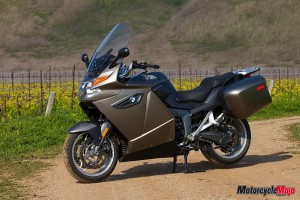 For 2009, BMW’s official position is, “The K1300GT is a facelift of the previous model,” but digging into the press material and the specification sheets, like most things BMW, this would appear to be an understatement. While the existing architecture remains the same, there are some significant changes aimed at a machine that, in my mind at least, really didn’t need much improvement. Starting with the power plant, the GT gets a displacement increase with an accompanying boost to the torque and horsepower output. As one of the smoothest and definitely the most luxurious engines in existence, I was interested to see how it’s possible to improve something that is so close to perfect.
For 2009, BMW’s official position is, “The K1300GT is a facelift of the previous model,” but digging into the press material and the specification sheets, like most things BMW, this would appear to be an understatement. While the existing architecture remains the same, there are some significant changes aimed at a machine that, in my mind at least, really didn’t need much improvement. Starting with the power plant, the GT gets a displacement increase with an accompanying boost to the torque and horsepower output. As one of the smoothest and definitely the most luxurious engines in existence, I was interested to see how it’s possible to improve something that is so close to perfect.
The first step was a displacement hike, enlarging the previous 1,157 cc capacity of the K1200GT to 1,293 cc for ’09. This gives the new bike an eight horsepower gain for a total of 160, and an additional 3.7 foot pounds of torque for a total of 99. A significant boost for the big K, but the real news is this power output now arrives at 9,000 rpm instead of 9,500 rpm. You are getting more power over a smaller range and it’s noticeable. With the bike producing over 80% of its peak torque figure from 3,500 rpm, it’s no wonder the GT feels like it’s never going to stop pulling. This displacement increase was made by increasing both bore and stroke, while valve sizes, valve angles and camshafts appear to have remained the same.
The result of all these changes just makes the 4-6,000 rpm point even stronger and more addictive as you feel as if you are piloting a frictionless turbine. It’s that smooth. During our test, some of my peers were experiencing fueling issues, but try as I might, the only thing I could come up with was a slight lag at times coming back on the throttle. Making this operation feel like a two-step process, it was something I had initially noticed. I’m sure the issues they experienced were reported to BMW, so hopefully would have been addressed before the bikes hit the show room. BMW has certainly had some struggles with their fuel injection over the years, but I really have nothing negative to really report about my ride on the new GT.
Throttle actuation is all new this year with a desmodromic operation, which is said to give more control. Digital Motor Electronics are used for the fuel injection system, and features BMW’s integrated anti-knock control (BMS-K). Using two body sound sensors between the cylinders, the slightest sign of pre-ignition has the electronic engine control unit retarding the ignition. This will allow BMW owners to run lower grade fuel when there is no premium available without having to adjust anything, and the result will be nothing more than a slight loss of power to deal with. On the other side of the fueling equation, the muffler contributes to the bikes increased torque without the need of an electronic exhaust valve.
On the highway somewhere just over 11,000 rpm, the rev limiter will kick in, but the bike makes such phenomenal amounts of horsepower at 9,000 rpm, I rarely felt the need to rev it that high. It starts pulling early and just keeps on pulling without any noticeable steps in the silky smooth power delivery. Making top gear overtaking manoeuvres so ridiculously easy, the biggest problem the GT is going to give you is paying attention to your speedometer to keep you out of trouble.
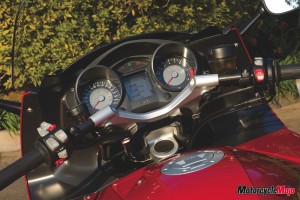 Power without control would be nothing, and I have no complaints about the previous GT’s handling and braking. Using the same beefy, aluminum bridge frame, there are some changes to the Duolever system up front. Weighing in a couple of pounds lighter this year, as it is now produced in aluminum not steel, the parallelogram front ends feels even more stable and confidence inspiring than before. There is also a newly designed lower arm. Losing a couple of pounds on a bike weighing in at 635 pounds full of fuel is going to be difficult to notice, but the confidence level afforded by the front end is just as good, and maybe even better. The wide bars make for very easy tip in, and the bikes agility through tight bends makes a mockery of the static spec sheets.
Power without control would be nothing, and I have no complaints about the previous GT’s handling and braking. Using the same beefy, aluminum bridge frame, there are some changes to the Duolever system up front. Weighing in a couple of pounds lighter this year, as it is now produced in aluminum not steel, the parallelogram front ends feels even more stable and confidence inspiring than before. There is also a newly designed lower arm. Losing a couple of pounds on a bike weighing in at 635 pounds full of fuel is going to be difficult to notice, but the confidence level afforded by the front end is just as good, and maybe even better. The wide bars make for very easy tip in, and the bikes agility through tight bends makes a mockery of the static spec sheets.
With no dive under braking, just a small pushing forward and upward feeling, you can push extremely hard into corners of all kinds, fast and slow. This rock solid stability allows you to run harder and later on the brakes and makes you turn with ease. Back off to a cruising pace, the same precision exists and you really gain an appreciation for the easy steering as the bike tips on its side with consummate ease. Picking up out of the turn the same way, you can be rolling on the gas very early as the chassis doesn’t need any time to settle after coming off the brakes. And, of course, with BMW’s optional ASC (Automatic Stability Control) traction control, you have the added security of knowing the rear tire isn’t going to spin. At the opposite end of traction control, ABS does come standard and both of these safety features just add to the quality of the BMW experience.
In the rear, the GT uses BMW’s signature Paralever single-sided swingarm that incorporates final shaft drive, and for 2009, the final drive gears are stronger for the extra power and torque of the new engine. A single shock is responsible for keeping the rubber on the road and sport bike sized seventeen-inch wheels are used front and back, allowing for a wide choice of rubber when replacement becomes necessary. Wearing a 190/55 ZR 17 on the rear and a 120/70 ZR 17 on the front, our test bikes came with a variety of different rubber from Metzeler and Continental, so I’m not sure what the fitment will be at your local dealer.
Always a strong point on BMWs, the GT’s brakes are exceptional again this year, and feature a pair of 320 mm discs up front and a single 294 mm unit out back. Four piston calipers put the iron handshake on the front and a dual piston caliper does duty on the rear. With BMW’s Semi Integral ABS system in place, you get all of the stopping you need with all the peace of mind available in the two-wheeled world. I tried both front and back to the point of the ABS kicking in, and it takes a heavy squeeze on the front lever to activate the ABS. When it does, the bike behaves without incident and you come quickly and safely to a stop.
Riding around Santa Barbara in beautiful sunny California, we experienced many different types of roads and terrains in a long day of riding. Cruising on the super slab, to flicking through tight switch backs or bumping along rough country lanes at varying speeds gave us the perfect opportunity to use BMW’s new electronically adjustable suspension (ESA II). Available as an option on the new GT for ’09, you can now adjust the spring pre-load at the touch of a button. For safety purposes this must be done at rest, but the changing between Normal, Sports and Comfort modes can still be done on the fly. Giving a range of nine different settings, as each spring rate you choose has the further three adjustment options, making it the most sophisticated system on the market. During our ride, I was swapping bikes, but did change to sport mode when necessary and back to comfort on the highway. The range of adjustment is larger this year, and the differences in the settings are very noticeable. To fully explain how this amazing system works would just about take another full article, so for those interested, it’s worth checking BMW’s web site for more information. For those not interested, there is an easy to use button that changes the LED display from one helmet to two etc, or lists Normal, Sports or Comfort depending on your choice.
With all that power and advance suspension and braking, the K1300GT also makes for a perfect touring machine with standard colour-matched side cases and luggage rack taking up the rear behind the seat. Both 32-litre side cases offer generous amounts of storage and easily hold a full-face helmet. The latching mechanism is easy to use and if left unlocked, a key is not required to open the cases. The key does release the bags easily from the bike and the integral handle makes them a breeze to carry into your hotel room, negating the need to pack and unpack at the bike each evening. The GT also comes standard with a useful locking glove box on the right hand side of the fairing to keep necessities handy. For those wishing more storage space, a 49-litre or 28-litre optional top boxes are also available.
Doing the math on the 24-litre fuel tank and BMW’s claimed 5 L/100 km, a rider should be able to theoretically log 480 km before sputtering to a stop, however, the fuel warning will come on with 4-litres in reserve giving you a generous 80 km to find a gas station.
One of the biggest conversation points about the new GT is the switchgear. Strange concept until you realize that BMW is now using conventional turn signal operation. Yes, you can indicate turning left and right with one switch on the left handlebar and cancel it with a light stab of the button. Finally figuring out they might be wrong and the rest of the motorcycle world might be right, it did provide for some laughs during the press brief.
It also provided some amusing moments during our test as I kept trying to use the old system and had to re-programme myself to not re-programme my thinking. If you know what I mean?
At this point I’m very aware of how poetically I’m waxing about the new GT, and folks, as many bikes as I ride, and as many times as I fly to get to them, I am excited to be able to report how much this bike excited me. There is just no area of compromise with the GT. All day comfort in the saddle, adjustable handlebars, good wind protection with the electrically operated windshield raised up to the highest position, plenty of luggage space and the optional heated seat and grips, it’s as tour friendly as any motorcycle produced, with a performance package that is more than enough for any road. I’m sure the Kawasaki Concours has a small performance advantage out on the edge of insanity, but it has to be very slight. I would give the GT the nod for comfort any day though. Yamaha’s FJR, while more sporting by nature, is starting to feel dated by comparison and the American V-twins are left sucking exhaust fumes and scraping metal parts in the bends when the GT’s throttle cables are stretched.
Visually, the bike is as fabulous as ever. Featuring superb quality finish from the saddlebags to the instruments, it’s no surprise a fully loaded GT will set you back $24,225. The base model starts at $21,825. There are a plethora of accessories available, and the machine comes in three colours: Red Apple Metallic, Royal Blue Metallic and Magnesium Beige Metallic. All bikes, regardless of colour, come with black drivetrain and suspension components listed as Asphalt Metallic.
For your money, you get one of the fastest, smoothest touring machines on the planet, and without any doubt, the most sophisticated machine on two wheels.
For more info on the K1300GT, go to www.bmw-motorrad.ca or your local dealer.









